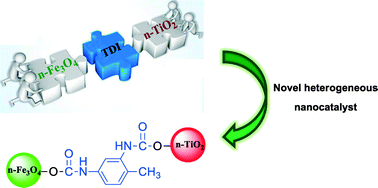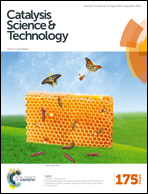A unique approach to magnetization of metal oxides: nano-Fe3O4@TDI@TiO2 as a highly efficient, magnetically separable and recyclable heterogeneous nanocatalyst†
Abstract
A highly efficient and magnetically recyclable nanocatalyst has been prepared by covalent grafting of Fe3O4 and TiO2 nanoparticles to 2,4-toluene diisocyanate as an inexpensive and highly reactive linker. The morphology and structure of this novel nanocatalyst were investigated by Fourier transform infrared spectroscopy (FT-IR), field emission scanning electron microscopy (FE-SEM), X-ray diffraction (XRD), thermogravimetric analysis (TGA) and vibrating sample magnetometry (VSM). The catalytic activity of the catalyst was probed for the synthesis of tetrahydrobenzo[b]pyran and hexahydroquinoline derivatives at 70 °C under solvent-free conditions with excellent yields and short reaction times. An experimental design was adopted to optimize the reaction conditions using central composite design (CCD). The catalyst can be readily separated by applying an external magnet device and recycled up to 6 times without significant decrease in catalytic activity, which makes it highly beneficial to address industrial needs and environmental concerns. This is the first study that reports a unique method for magnetization of metal oxides through the usage of TDI as a linker and creating a nanocatalyst by covalent grafting of two metal oxides. Moreover, this method could be extended to link other different metal oxides as well as magnetic ones.


 Please wait while we load your content...
Please wait while we load your content...